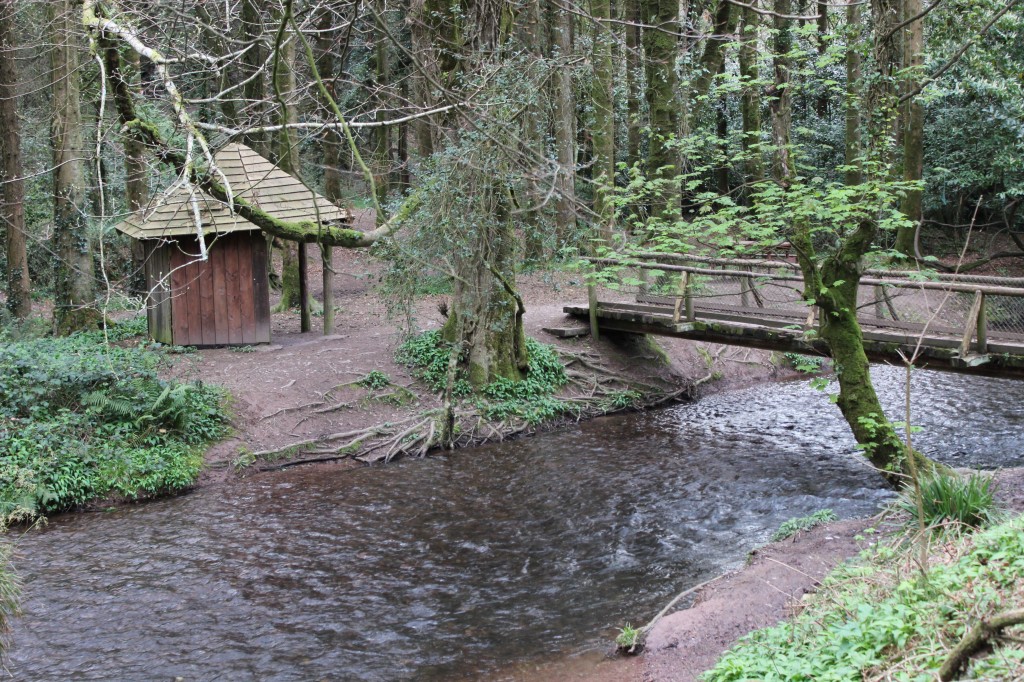Nature Trail
Following the breaching of the lake this nature trail was drawn up.
Stop 1 This is a native Irish Tree, the Sessile Oak. It is recognised by it’s heavily grooved bark  and it’s characteristic deeply indented leaves. It seeds by producing acorns and has brown buds in winter. The oak is host to more insects than any other tree, and consequently it is very important as a wildlife tree. Many birds feed in its branches and nest in holes which develop as the tree ages. The ivy growing on this tree is not a parasitic plant and only uses the tree trunk for support. Ivy provides both food and shelter for birds. On the opposite side of the avenue is the Holm or Evergreen Oak, a species native to North Africa and Southern Europe.
and it’s characteristic deeply indented leaves. It seeds by producing acorns and has brown buds in winter. The oak is host to more insects than any other tree, and consequently it is very important as a wildlife tree. Many birds feed in its branches and nest in holes which develop as the tree ages. The ivy growing on this tree is not a parasitic plant and only uses the tree trunk for support. Ivy provides both food and shelter for birds. On the opposite side of the avenue is the Holm or Evergreen Oak, a species native to North Africa and Southern Europe.
Stop 2 This huge coniferous tree is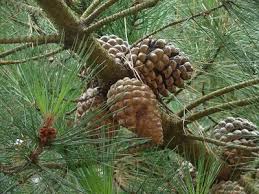 Monterey Pine. It produces very large cones and these may be retained on the tree for up to 40 years. It is a native of California. In summer it is nice to sit under the tree and look straight up at the sky. It creates the illusion that the tree is about to topple over!
Monterey Pine. It produces very large cones and these may be retained on the tree for up to 40 years. It is a native of California. In summer it is nice to sit under the tree and look straight up at the sky. It creates the illusion that the tree is about to topple over!
Stop 3 This beautiful tree is the Copper Beech which is a cultivated form of the Common Beech. All types of beech have been introduced from England and Europe and they have been planted widely in old estates.
which is a cultivated form of the Common Beech. All types of beech have been introduced from England and Europe and they have been planted widely in old estates.
Stop 4 Bay trees grow all over Glenbower wood although they are not usually found growing in the wild. Here is a picture of bay leaves from a bay tree. The leaves are widely used in cooking.
usually found growing in the wild. Here is a picture of bay leaves from a bay tree. The leaves are widely used in cooking.
Stop 5 Facing you is an oak tree which is interesting for two reasons. Firstly, there is a stone embedded in the trunk, and secondly, a young Holly bush has managed to take root and thrive in the trunk of the oak. Holly, a native species, often forms the understory in deciduous woodlands.
Stop 6 This is another Common Beech with four main branches. One of the branches was obviously badly damaged in the past. Trees cannot grow without the cambium layer, which is a bright green tissue beneath the bark. If the cambium is exposed a “wound” results and trees may be deformed or die due to disease entering through the wound. Please do not damage trees in the wood by carving names in the bark!
Stop 7 Here we find more oak trees. Notice the moss and lichens growing on the trunk of the trees; this indicates an unpolluted environment. You will also notice the fern, Polypody, growing on the branches of this and other trees in the wood. The footpath here is a former mill race. Up to 1948 the water running through this channel caused the erosion noticable on the banks.
Stop 8 At this stop we can see examples of the plants which are usually found growing under hardwoods,especially the oak.There is an abundance of Wild Garlic distinguishable by it’s strong smell. Also present are Herb Bennett, Herb Robert, Nettle, Lesser Celendine, Lords and Ladies and several species of ferns.These plants form the ground layer of the woodland flora. Honeysuckle, also called Woodbine, is a climbing plant and produces lovely flowers which give off a most beautiful scent at dusk. Many plants which flower in spring such as Bluebell and violets make use of the sunshine before the hardwood canopy casts it’s summer shade.
Stop 9 At this stop we are at a river crossing with a beautiful wooden footbridge. This used to be the spot where you could first distinguish the rumbling sounds from the man-made waterfall which was situated further upstream. Unfortunately the Lake had to be drained on expert advice for reasons of safety and the river was re-routed which is why there is no longer a waterfall.
Stop 10 Rivers are very important features of the environment. Brown Trout are found here and Salmon spawn in this river.The Otter, an endangered species in many countries, also occurs here. However, these are very shy animals and are mainly nocturnal.
Stop 11 This species of tree is called Tsuga or  “Western hemlock”. There are no plants growing under these trees, apart from some Woodrush and Hard Fern at the edge, as the sun cannot penetrate the dense canopy of the trees which monopolise it for their own growth requirements.
“Western hemlock”. There are no plants growing under these trees, apart from some Woodrush and Hard Fern at the edge, as the sun cannot penetrate the dense canopy of the trees which monopolise it for their own growth requirements.
Stop 12 When the Earthen dam forming Glenbower Lake was built, a canal was excavated through the rock to take the overflow of water not needed to work the mills of Killeagh. The erosive power of the torrent over the years is apparent in the overhanging wall of rock. A fish pass can be seen at the far side of the bridge. It is a concrete construction with vertical timber boards placed at intervals on each side to allow salmon a resting place on their journey.
Stop 13 When you look down to the right you can see the colonisation of what used to be the lake bed.It is inhabited mostly by Willows, also known as Sallys. Nettle and other hardy perennials also abound here. Hopefully in the future the lake will be restored to its former beauty.
Stop 14 The shrubs growing to the right and 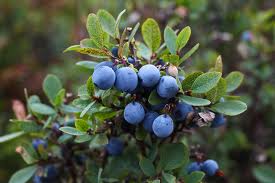
left of the path are called Bilberry or Whortleberry.These produce edible fruits in the autumn called whorts. If you stop and listen here, particularly in the morning, you will hear a chorus of bird song.The songsters include Wren, Robin, Blackbird, Song Thrush, Blue Tit and Chaffinch. The river here is often visited by the solitary Grey Heron.
Stop 15 These bushy multi-stemmed trees 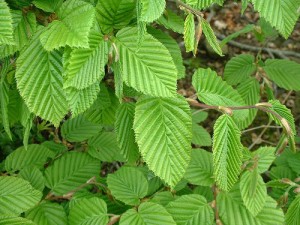 are Hazels. They are native trees. They produce edible nuts in abundance and they are popular with Red Squirrels and small mammals such as Field Mice and Bank Voles.Contrary to popular belief squirrels do not hibernate or store nuts in any systematic fashion but continue to seek food during the winter, even in very cold weather.
are Hazels. They are native trees. They produce edible nuts in abundance and they are popular with Red Squirrels and small mammals such as Field Mice and Bank Voles.Contrary to popular belief squirrels do not hibernate or store nuts in any systematic fashion but continue to seek food during the winter, even in very cold weather.
Stop 16 Here is a young Elm tree. It is the only one I have ever seen in Glenbower. It has so far escaped the ravages of Dutch Elm’s disease which was identified by scientists in Holland in 1917 and spread quickly wiping out many European Elms. New Strains appeared in England in the 1960’s causing further devastation of the Elm population.
Stop 17 This bridge,called the Metal Bridge, and the 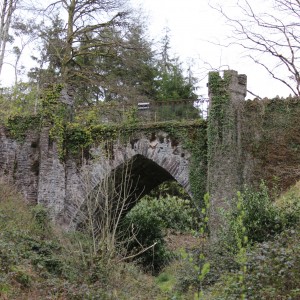 original White Bridge further upstream were the beginnings of the planned improvements to access on the estate by the landlord de Cappell Brooke in the early 1830s. There is elaborate workmanship in stone and iron on the bridge parapet. There are spectacular Rhododendron here, the roots are at ground level and the blooms appear just at the top of the bridge and just out of reach. Although beautiful, Rhododendron tends to take over a woodland if it is not controlled.
original White Bridge further upstream were the beginnings of the planned improvements to access on the estate by the landlord de Cappell Brooke in the early 1830s. There is elaborate workmanship in stone and iron on the bridge parapet. There are spectacular Rhododendron here, the roots are at ground level and the blooms appear just at the top of the bridge and just out of reach. Although beautiful, Rhododendron tends to take over a woodland if it is not controlled.
Stop 18 The trees at the final stop are Ash. 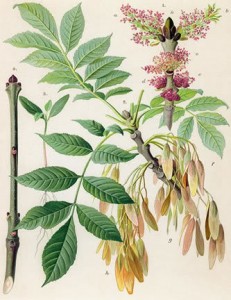 The Ash also has a compound leaf.The seeds which are produced in autumn have wings which aid their dispersal.In winter it can be identified by it’s smooth bark and black buds.Hurley sticks are traditionally cut from the butt end of the Ash. This is in order to provide a curving grain on the hurley “bos”. Ash is also used in many other ways for sports goods where lightness coupled with elasticity and strength are required.
The Ash also has a compound leaf.The seeds which are produced in autumn have wings which aid their dispersal.In winter it can be identified by it’s smooth bark and black buds.Hurley sticks are traditionally cut from the butt end of the Ash. This is in order to provide a curving grain on the hurley “bos”. Ash is also used in many other ways for sports goods where lightness coupled with elasticity and strength are required.
This is a picture of one of the Wooden Huts you will find in the woods.They provide shelter from showers and of course a place to eat your sandwiches!
